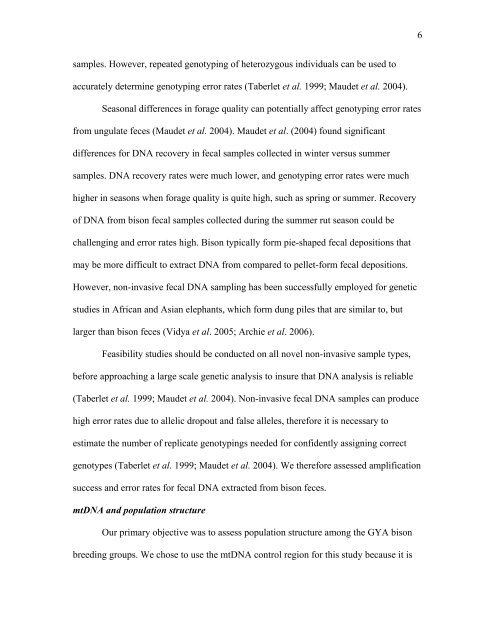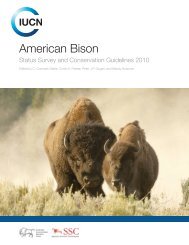Declaration Dr. Thomas H. Pringle - Buffalo Field Campaign
Declaration Dr. Thomas H. Pringle - Buffalo Field Campaign
Declaration Dr. Thomas H. Pringle - Buffalo Field Campaign
You also want an ePaper? Increase the reach of your titles
YUMPU automatically turns print PDFs into web optimized ePapers that Google loves.
samples. However, repeated genotyping of heterozygous individuals can be used to<br />
accurately determine genotyping error rates (Taberlet et al. 1999; Maudet et al. 2004).<br />
Seasonal differences in forage quality can potentially affect genotyping error rates<br />
from ungulate feces (Maudet et al. 2004). Maudet et al. (2004) found significant<br />
differences for DNA recovery in fecal samples collected in winter versus summer<br />
samples. DNA recovery rates were much lower, and genotyping error rates were much<br />
higher in seasons when forage quality is quite high, such as spring or summer. Recovery<br />
of DNA from bison fecal samples collected during the summer rut season could be<br />
challenging and error rates high. Bison typically form pie-shaped fecal depositions that<br />
may be more difficult to extract DNA from compared to pellet-form fecal depositions.<br />
However, non-invasive fecal DNA sampling has been successfully employed for genetic<br />
studies in African and Asian elephants, which form dung piles that are similar to, but<br />
larger than bison feces (Vidya et al. 2005; Archie et al. 2006).<br />
Feasibility studies should be conducted on all novel non-invasive sample types,<br />
before approaching a large scale genetic analysis to insure that DNA analysis is reliable<br />
(Taberlet et al. 1999; Maudet et al. 2004). Non-invasive fecal DNA samples can produce<br />
high error rates due to allelic dropout and false alleles, therefore it is necessary to<br />
estimate the number of replicate genotypings needed for confidently assigning correct<br />
genotypes (Taberlet et al. 1999; Maudet et al. 2004). We therefore assessed amplification<br />
success and error rates for fecal DNA extracted from bison feces.<br />
mtDNA and population structure<br />
Our primary objective was to assess population structure among the GYA bison<br />
breeding groups. We chose to use the mtDNA control region for this study because it is<br />
6










